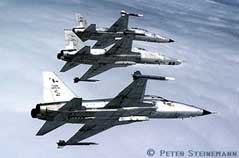 |
|||||
Main>Articles>Military Stuff>F-5E Tiger II
Northtrop
Grumman F-5 Tiger II
 This aircraft
is originally based on the T-38 Talon trainer jet used by the USAF. The
first version of the Tiger, the F-5A flew for the first time in 1963 before
being exported around the globe, particularly to countries not under Communist
influence. This fighter is easy to maintain, low in purchase and maintenance
costs as well as capable of supersonic speeds.
This aircraft
is originally based on the T-38 Talon trainer jet used by the USAF. The
first version of the Tiger, the F-5A flew for the first time in 1963 before
being exported around the globe, particularly to countries not under Communist
influence. This fighter is easy to maintain, low in purchase and maintenance
costs as well as capable of supersonic speeds.
Although the first-generation F-5s were seen a worthy competitor to the
Soviet MiG-21, the USA decided that its allies required a more sophisticated
but cheap fighter jet. This need resulted in the International Fighter
Aircraft (IFA) program, which was under the USAF. Four firms submitted
proposals as well as prototypes and in the end, Northrop, with an upgraded
F-5A finally won the project. The modifications made to the F-5A resulted
in a new classification for the aircraft, the F-5E Tiger II. 
Despite bearing a striking resemblance to the F-5A,
this new aircraft had several major differences. Its body was 38cm
longer and has a wingspan that is 40.6cm longer. These changes were made
to accommodate a new 671 gallon fuel tank.
The avionics were also radically improved. The F-5E came equipped with
the lightweight Emerson Electric AN/APQ-159 radar with a maximum detection
range of 37km. This radar is coupled with a lead-computing optical sight,
which is the AN/ASG-31.
The Malaysian government ordered a total of 14 F-5E Tiger IIs in 1975.
These aircraft were operated by the 12 Squadron in Butterworth AFB as
fighter interceptors. Among the standard avionics that came with the aircraft
included the Litton LN-33 inertial navigation system, AN/ARN-84(V) TACAN,
Magnavox AN/ARC-50 UHF radios as well as the AN/APX-72 IFF/SIF. The aircraft
were also equipped with tailhooks for emergency landings.
The RMAF F-5Es were armed with AIM-9 Sidewinders as well as bombs and
air-to-surface missiles for interdiction and close air support missions.
Fordogfighting, the aircraft were equipped with two built-in M39A2 20mm
cannons with 280 rounds of ammunition. These guns were mounted on each
side of the nose.
For pilot training purposes, the RMAF also acquired 4 F-5F two-seaters.
These planes were rather similar except that they had only one cannon.
 The
RMAF was also the first country in the world to purchase the RF-5E Tigereye
reconnaissance aircraft. This modified F0Ee had a radically modified nose,
which increased space for equipment by up to nine times. The nose was
fitted with a KS-97B camera. Although smaller and less costly, the Tigereye
offered the same reconnaissance capabilities as the RF-4E. Apart from
recon missions, the Tigereye retained all the other combat capabilities
of the F-5E. The RMAF has had 2 RF-5Es in operation since 1983 serving
under the 11 Squadron.
The
RMAF was also the first country in the world to purchase the RF-5E Tigereye
reconnaissance aircraft. This modified F0Ee had a radically modified nose,
which increased space for equipment by up to nine times. The nose was
fitted with a KS-97B camera. Although smaller and less costly, the Tigereye
offered the same reconnaissance capabilities as the RF-4E. Apart from
recon missions, the Tigereye retained all the other combat capabilities
of the F-5E. The RMAF has had 2 RF-5Es in operation since 1983 serving
under the 11 Squadron.
From its induction into the RMAF, the Tiger II was widely used in strike
missions against communist terrorist camps. These missions were jointly
conducted with the Tebuan, with Alouttes acting as FACs. Since then, the
RMAF has acquired several more Tiger IIs as attrition spares as well as
replacements for those lost in operation. This aircraft has had a reputation
among RMAF pilots for having a steep learning curve, though many would
vouch for it as being a great plane to fly. It has also proven to be very
cheap and easy to maintain. In joint exercises, pilots of other aircraft
have found the Tiger II to be quite hard to locate with radar from a long
distance as well as to track visually because of its small size. It has
also quite agile for a plane of its class. Despite all these, the RMAF
Tiger IIs are stuck in aging airframes with outdated radars and avionics.
In view of this, the MoD has awarded a local firm, Langkawi R&D (LARDAC)
Sdn. Bhd a contract to upgrade the RMAF’s fleet of F-5Es. Initally,
a single F-5F will be upgraded as a demonstrator. If it meets the criteria
of the MoD, another RM480 million will be provided to upgrade the entire
fleet. Among the features of the upgrade will include a new Italian-made
Griffo radar as well as new avionics (glass cockpit,GPS navigation etc.).
The life of the airframes will also be extended for at least another 10
years.
Crew : 1
Length : 14.68m
Height : 4.06m
Wingspan : 8.13m
Max. Takeoff Weight : 11,214kg
Ceiling : 15,540m
Max. Speed : Mach 1.63
Operational Range : 222km
Back